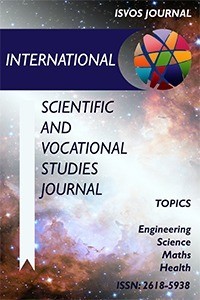A Comparison of Five Methods for Missing Value Imputation in Data Sets
Missing value imputation, k-nearest neighbor, singular value decomposition, bayesian principal component analysis, missForest
A Comparison of Five Methods for Missing Value Imputation in Data Sets
Missing value imputation, k-nearest neighbor, singular value decomposition, bayesian principal component analysis, missForest,
___
- [1] T.D. Pigott, “A review of methods for missing data”, Educational Resarch and Evaluation, Cilt. 7, s. 353-383. DOI: 10.1076/edre.7.4.353.8937, 2001.
- [2] P.D. Allison, “Missing data techniques for structural equation modeling”, Journal of Abnormal Psychology, Cilt. 4, s. 545-557. DOI: 10.1037/0021-843X.112.4.545, 2003.
- [3] J.W. Osborne, “Best practices in data cleaning”, California: Sage Publication, Inc., s. 596, 2013.
- [4] A.G. Di Nuovo, “Missing data analysis with fuzzy C-Means: A study of its application in a psychological scenario”, Expert Syst Appl, Cilt. 38, s. 6793-6797, DOI: 10.1016/j.eswa.2010.12.067, 2011.
- [5] C. Bergmeir, J.M. Benitez, “On the use of cross-validation for time series predictor evaluation”, Inform Sciences, Cilt. 191, s. 192-213, DOI: 10.1016/j.ins.2011.12.028, 2012.
- [6] J. Van Hulse, and T.M. Khoshgoftaar, “Incomplete-case nearest neighbor imputation in software measurement data”, IRI 2007: Proceedings of the 2007 IEEE International Conference on Information Reuse and Integration, s. 630-637 DOI: 10.1109/IRI.2007.4296691, 2007.
- [7] S. Genc, F.E.Boran, D. Akay, and Z.S. Xu, “Interval multiplicative transitivity for consistency, missing values and priority weights of interval fuzzy preference relations”, Inform Sciences, Cilt. 180, s. 4877-4891, DOI: 10.1016/j.ins.2010.08.019, 2010.
- [8] R.J.A. Little, and D.B. Rubin, “Statistical Analysis with Missing Data”, 333. John Wiley & Sons, 2014.
- [9] O. Troyanskaya, M. Cantor, G. Sherlock, P. Brown, T. Hastie, vd. “Missing value estimation methods for dna microarrays”, Bioinformatics, Cilt. 17, s. 520-525, 2001.
- [10] S. Oba, M.A. Sato, I. Takemasa, M. Monden, K.I. Matsubara, and S. Ishii, “A bayesian missing value estimation method for gene expression profile data”, Bioinformatics, Cilt. 19, s. 2088-2096, DOI: 10.1093/bioinformatics/btg287, 2003.
- [11] D.J. Stekhoven, and P. Buhlmann, “Miss Forest - nonparametric missing value imputation for mixed-type data”, Bioinformatics. Cilt. 28, s. 112-118, DOI: 10.1093/bioinformatics/btr597, 2012.
- [12] T. Marwala, “Computational intelligence for missing data imputation, estimation and management:knowledge optimization techniques”, Information Science Reference, Hershey PA, 2009.
- [13] P. Cihan, “Veri madenciliği yöntemleriyle hayvan hastalıklarında teşhis, prognoz ve risk faktörlerinin belirlenmesi”. Yıldız Teknik Üniversitesi, Fen Bilimleri Enstitüsü, Doktora Tezi, 101s, İstanbul, 2018.
- [14] Lichman, M. UCI Machine Learning Repository, http:// archive.ics.uci.edu/ml (Erişim Tarihi: 15.03.2018).
- [15] L. Breiman, Random forests, in: Machine Learning, Kluwer Academic Publishers, 2001.
- [16] R.S. Marko, “Improving random forests”, In: European conference on machine learning, Springer, Berlin, Heidelberg, 2004.
- [17] H. Kim, H. Kim, H. Moon, and H. Ahn, “A weight-adjusted voting algorithm for ensembles of classifiers”, J. Korean Stat. Soc., Cilt. 40, s. 437-449, DOI: 10.1016/j.jkss.2011.03.002, 2011.
- [18] H.B. Li, W. Wang, H.W. Ding, and J. Dong, “Trees weighting random forest method for classifying high-dimensional noisy data”, e-Business Engineering (ICEBE) in: 2010 IEEE 7th International Conference on IEEE, s. 160–163, 2010.
- ISSN: 2618-5938
- Yayın Aralığı: Yılda 2 Sayı
- Başlangıç: 2017
- Yayıncı: Umut SARAY
Analytical Design of PI Controllers for First Order plus Time Delay Systems
A Comparison of Five Methods for Missing Value Imputation in Data Sets
Bengi ŞANLI, Elif TURNA DİLSEL
Classification and Diagnostic Prediction of Breast Cancers via Different Classifiers
A Reduced Reference Metric for Enhanced 3D Video Perception
The Mesozoic Stratigraphy and Ammonite Faune for Niksar-Erbaa (Tokat) Territory
Performance Analysis of Storage, Grid Connected Hybrid Photovoltaic System
Optimization of Polyethylene Inserts Design Geometry of Total Knee Prosthesis
Burak ÖZTÜRK, Levent UĞUR, Fehmi ERZİNCANLI, Özkan KÜÇÜK
The Mesozoic Stratigraphy And Ammonite Fauna Of Ladik-Akdag (Samsun) Territory
Exterior Scaffolds of Prefabricated Components, Loads Affecting Scaffolds and Scaffold Experiments
